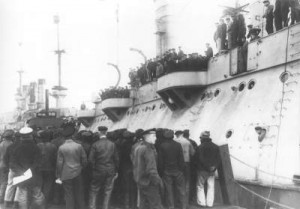The Kiel mutiny unfolded in late 1918, as the war drew to a close, German sailors mutinied and the Kaiser’s government collapsed. By September 1918 German generals were resigned to the fact they could not win the war. In October 1918, Kaiser Wilhelm II named Prince Max von Baden, a minor royal of liberal political views, as chancellor. This appointment, it was hoped, would facilitate armistice negotiations with the Allies – preferably with the Americans, who were viewed as being more reasonable. The day after his appointment, von Baden contacted US president Woodrow Wilson with peace overtures. Wilson was at first prepared to broker a ceasefire – until when London and Paris became aware of his actions, they intervened. On October 23rd, von Baden was told that no armistice would be possible without an unconditional German surrender.
But as von Baden was working to negotiate a ceasefire, German U-boats were continuing their aggression against Allied mercantile shipping. Three Allied vessels were attacked in October 1918, a factor in the Allied refusal to accept any terms other than total surrender. Its U-boat campaign aside, the German admiralty had failed; the Kaiser’s fleet had spent most of the war in port at Wilhelmshaven and Kiel, boxed in by Allied ships and mines. The war’s only major European naval engagement, the Battle of Jutland (1916), did not affect the British Royal Navy’s dominance. With the war drawing to an end, the German admiralty gave orders to instigate one last major North Sea battle. Two German destroyer groups would break from the harbour and attack the French and British coastline, enticing Allied ships to respond. Once in the open, they would be engaged by German U-boats and the rest of the Kaiser’s fleet. It would be, according to Admiral Reinhard Scheer, “an honourable battle, even if it became a death struggle”.
“Whether the sailors and soldiers identified with any socialist party is difficult to ascertain with any certainty. They raised the usual red flags, but those flags were just as likely to stand for a bourgeois republic and improved living conditions as for the creation of a vaguely conceived socialist order. What is clear is that the Kiel mutiny was the opening volley in a period of intense social unrest in central Europe that was to continue well into 1923, during which the fate of Europe itself seems to hang in the balance.”
Murray Bookchin, historian
But Operation Plan 19, as it was called, was little more than a suicide mission. The German navy, for all its ingenuity and U-boat strength, was hopelessly outnumbered and outgunned by the Allied fleet, which included British, British Commonwealth, French and American ships. German officers seemed to acknowledge, accept and even relish this fact; on receiving their orders, some were observed drinking joyful toasts to the imminent battle and the “death of the Kaiserliche Marine”. Enlisted men responded much differently. Few were interested in sacrificing their lives in the freezing waters of the North Sea, in order that the Admiralty might restore some of its lost prestige. On October 29th, sailors aboard two major ships at Kiel failed to return from shore leave. Within a few hours, the revolt had spread to several battleships and cruisers.
The growing mutiny forced the admiralty to abandon Operation Plan 19. Instead, they attempted to divide and disperse the mutineers by relocating the troubled ships to other German ports. Within 48 hours, the mutiny had spread to other ports and naval stations. On November 3rd the sailors at Kiel, joined by workers from the nearby city, detained their officers and took control of their ships. They also formed elected councils, not dissimilar to the ‘workers’ soviets’ that had precipitated the Russian Revolution the previous year. Echoing the fourteen-point peace plan of US president Woodrow Wilson, the Kiel mutineers drafted their list of demands, the first six points being:
1. The release of all inmates and political prisoners.
2. Complete freedom of speech and the press.
3. The abolition of mail censorship.
4. Appropriate treatment of crews by superiors.
5. No punishment for comrades returning to ships and barracks.
6. No launching of the fleet under any circumstances.”
As the days passed, the Kiel mutiny spread across Germany and adopted a distinctly political tone. What had begun as a revolt against orders had transformed into a fully fledged political revolution. Workers’ councils in Hamburg, Bremen, Lubeck, Munich and other cities demanded political reforms: the abdication of the Kaiser and of local princes, the end of aristocratic privilege, the empowerment of the Reichstag and the implementation of socialist policies. On November 7th the Bavarian king, Ludwig III, fled to Austria in fear of his life; he later surrendered his power to a republican government. But Ludwig would not be the last nor the most significant German royal to be dethroned. Two days later, the Kaiser himself was forced from power, beginning Germany’s transition to republican government.

1. In late October 1918, German ships were given orders to instigate one last major battle in the North Sea.
2. The news of this apparent suicide mission instigated a rebellion amongst the enlisted ranks stationed in Kiel.
3. On the day the attack was to commence, Kiel sailors refused to return to their ships, sparking a mutiny.
4. The Kiel mutiny quickly grew, drawing in workers and spreading to naval bases and cities around Germany.
5. The political councils formed as a result of Kiel demanded republican and socialist reform, leading to the abdication of several German royals, including Kaiser Wilhelm II.
© Alpha History 2014. Content on this page may not be republished or distributed without permission. For more information please refer to our Terms of Use.
This page was written by Jennifer Llewellyn, Jim Southey and Steve Thompson. To reference this page, use the following citation:
J. Llewellyn et al, “The Kiel mutiny”, Alpha History, 2014, accessed [today’s date], http://alphahistory.com/weimarrepublic/kiel-mutiny/.

